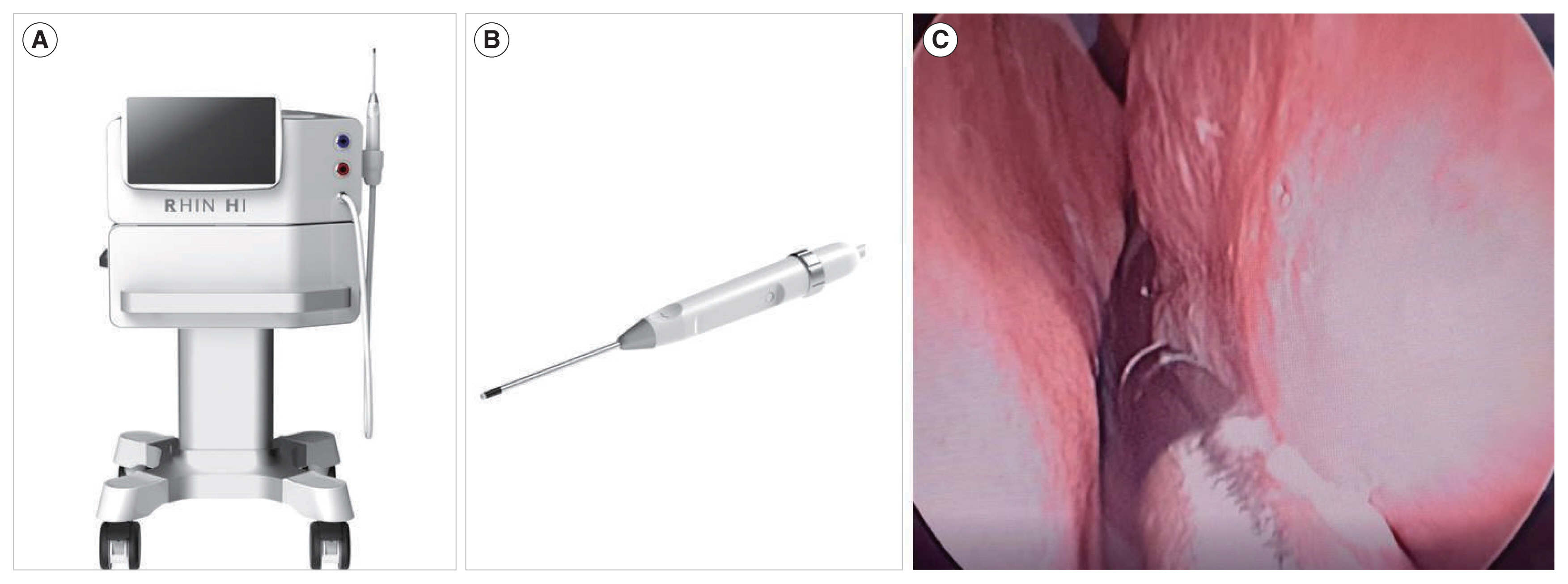Clin Exp Otorhinolaryngol.
2023 May;16(2):141-147. 10.21053/ceo.2022.01312.
High-Intensity Focused Ultrasound Therapy Versus Coblation for the Treatment of Inferior Turbinate Hypertrophy: A Clinical Trial
- Affiliations
-
- 1Department of Otolaryngology-Head & Neck Surgery, Hanyang University Guri Hospital, Guri, Korea
- 2GTG Wellness Co. LTD, Seoul, Korea
- 3Korea Electronics Technology Institute, Seongnam, Korea
- 4Team Interface Co. LTD, Seoul, Korea
- KMID: 2542355
- DOI: http://doi.org/10.21053/ceo.2022.01312
Abstract
Objectives
. To compare the efficacy and safety of high-intensity focused ultrasound (HIFU) therapy with coblation for the treatment of inferior turbinate hypertrophy (ITH).
Methods
. In this randomized controlled clinical trial, 20 patients underwent inferior turbinate surgery, which consisted of either HIFU or coblation therapy. Efficacy, safety, and tolerability were evaluated by subjective symptom scores, acoustic rhinometry, and nasal endoscopy.
Results
. The modified nasal obstruction symptom evaluation (NOSE) score and nasal obstruction visual analog scale (NO-VAS) significantly decreased in both groups 12 weeks postoperatively. The between-group differences in the evaluation scores were not statistically significant. On nasal endoscopy, the HIFU patients showed improvements in mucosal swelling sooner than the patients undergoing coblation therapy. Nasal crusting significantly increased in the patients undergoing coblation compared to the patients undergoing HIFU therapy until postoperative week 4. Mucosal preservation was superior in the HIFU patients. Although HIFU was less painful than coblation therapy during the procedure, the difference was not significant (4.9 vs. 6.3, P=0.143). The difference in global satisfaction between the two groups was not statistically significant, although satisfaction was slightly higher among the HIFU patients than among the coblation patients (4.6 vs. 4.1, P=0.393).
Conclusion
. HIFU provided results similar to those of coblation therapy for patients with nasal obstruction due to ITH, but HIFU therapy caused less discomfort during the procedure. HIFU therapy appears to be a good noninvasive alternative to the current surgical modalities for ITH.
Keyword
Figure
Reference
-
1. Gindros G, Kantas I, Balatsouras DG, Kaidoglou A, Kandiloros D. Comparison of ultrasound turbinate reduction, radiofrequency tissue ablation and submucosal cauterization in inferior turbinate hypertrophy. Eur Arch Otorhinolaryngol. 2010; Nov. 267(11):1727–33.
Article2. Hol MK, Huizing EH. Treatment of inferior turbinate pathology: a review and critical evaluation of the different techniques. Rhinology. 2000; Dec. 38(4):157–66.3. Porter MW, Hales NW, Nease CJ, Krempl GA. Long-term results of inferior turbinate hypertrophy with radiofrequency treatment: a new standard of care? Laryngoscope. 2006; Apr. 116(4):554–7.
Article4. Passali D, Lauriello M, Anselmi M, Bellussi L. Treatment of hypertrophy of the inferior turbinate: long-term results in 382 patients randomly assigned to therapy. Ann Otol Rhinol Laryngol. 1999; Jun. 108(6):569–75.
Article5. Shah AN, Brewster D, Mitzen K, Mullin D. Radiofrequency coblation versus intramural bipolar cautery for the treatment of inferior turbinate hypertrophy. Ann Otol Rhinol Laryngol. 2015; Sep. 124(9):691–7.
Article6. Lee KC, Hwang PH, Kingdom TT. Surgical management of inferior turbinate hypertrophy in the office: three mucosal sparing techniques. Oper Tech Otolayngol Head Neck Surg. 2001; Jun. 12(2):107–11.
Article7. Fradis M, Golz A, Danino J, Gershinski M, Goldsher M, Gaitini L, et al. Inferior turbinectomy versus submucosal diathermy for inferior turbinate hypertrophy. Ann Otol Rhinol Laryngol. 2000; Nov. 109(11):1040–5.
Article8. Wu F, Chen WZ, Bai J, Zou JZ, Wang ZL, Zhu H, et al. Pathological changes in human malignant carcinoma treated with high-intensity focused ultrasound. Ultrasound Med Biol. 2001; Aug. 27(8):1099–106.
Article9. Pomonis JD, Rogers SD, Peters CM, Ghilardi JR, Mantyh PW. Expression and localization of endothelin receptors: implications for the involvement of peripheral glia in nociception. J Neurosci. 2001; Feb. 21(3):999–1006.
Article10. Feng GF, Han ZL, Wang F, Sun BC, Dai ZY, Yang SZ, et al. Comparison of high-intensity focused ultrasound therapy under nasal endoscopy guidance versus first-line drug treatment in patients with persistent allergic rhinitis. Genet Mol Res. 2015; Aug. 14(3):9865–71.
Article11. Kim JK, Cho SW, Kim H, Jo SC, Kim HG, Won TB, et al. Development of high-intensity focused ultrasound therapy for inferior turbinate hypertrophy. Clin Exp Otorhinolaryngol. 2022; May. 15(2):160–7.
Article12. Kennedy JE, Ter Haar GR, Cranston D. High intensity focused ultrasound: surgery of the future? Br J Radiol. 2003; Sep. 76(909):590–9.
Article13. Kennedy JE, Wu F, ter Haar GR, Gleeson FV, Phillips RR, Middleton MR, et al. High-intensity focused ultrasound for the treatment of liver tumours. Ultrasonics. 2004; Apr. 42(1–9):931–5.14. Leslie TA, Kennedy JE. High-intensity focused ultrasound principles, current uses, and potential for the future. Ultrasound Q. 2006; Dec. 22(4):263–72.
Article15. Wei H, Zhang Y, Shi L, Zhang J, Xia Y, Zang J, et al. Higher dosage of HIFU treatment may lead to higher and longer efficacy for moderate to severe perennial allergic rhinitis. Int J Med Sci. 2013; Nov. 10(13):1914–20.
Article16. Zhong B, Li LK, Deng D, Du JT, Liu YF, Liu F, et al. Effect of high-intensity focused ultrasound versus plasma radiofrequency ablation on recurrent allergic rhinitis. Med Sci Monit. 2019; Sep. 25:6775–81.
Article17. Kim CS, Moon BK, Jung DH, Min YG. Correlation between nasal obstruction symptoms and objective parameters of acoustic rhinometry and rhinomanometry. Auris Nasus Larynx. 1998; Jan. 25(1):45–8.
Article18. Isaac A, Major M, Witmans M, Alrajhi Y, Flores-Mir C, Major P, et al. Correlations between acoustic rhinometry, subjective symptoms, and endoscopic findings in symptomatic children with nasal obstruction. JAMA Otolaryngol Head Neck Surg. 2015; Jun. 141(6):550–5.
Article
- Full Text Links
- Actions
-
Cited
- CITED
-
- Close
- Share
- Similar articles
-
- Coblation Turbinate Reduction in Patient with Nasal Obstruction
- Septoplasty and Turbinoplasty ; Current Concept and Technique
- Structural Changes of Inferior Turbinate in Patients with Septal Deviation: Surgical Implication
- Laser-Assisted versus Coblation-Assisted Partial Turbinoplasty: Comparison by Their Postoperative Outcome
- The Relationship between Nasal Septal Deviation and Inferior Turbinate Hypertrophy



